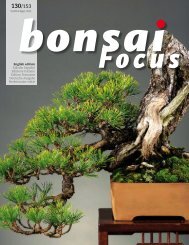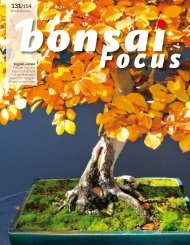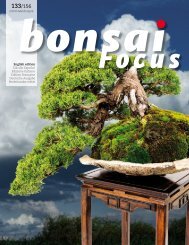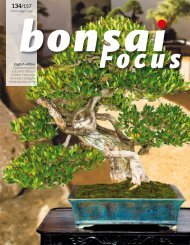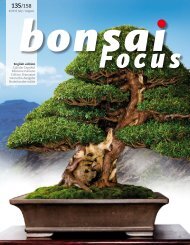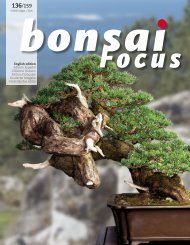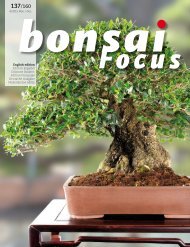BONSAI FOCUS 2016-2 EN PREVIEW
Discover how fascinating Bonsai Focus is! With informative reports and stunning photography every two months, Bonsai Focus Magazine makes you eye-witness extraordinary bonsai, magnificent stylings of famous masters, educational techniques and useful maintenance tips. Articles are often supported by exclusive and breathtaking videos.
Discover how fascinating Bonsai Focus is! With informative reports and stunning photography every two months, Bonsai Focus Magazine makes you eye-witness extraordinary bonsai, magnificent stylings of famous masters, educational techniques and useful maintenance tips. Articles are often supported by exclusive and breathtaking videos.
You also want an ePaper? Increase the reach of your titles
YUMPU automatically turns print PDFs into web optimized ePapers that Google loves.
72 Bonsai Focus<br />
TECHNIQUE<br />
Sowing the seeds...5<br />
Fagus: The challenge is to create a finished tree starting from zero<br />
Text and photography: Kinbon magazine, Japan Illustrations: Kyousuke Gun<br />
One of the ultimate challenges in bonsai is to create a tree from seed.<br />
This time we focus on beech and follow it through the years from seed to a formal upright<br />
Leaf and seed type<br />
In places with strong wind, you will see trees growing into shapes<br />
that defy imagination. 1,700 m / 5,577 ft elevation.<br />
Low elevation trees<br />
Seeds are smaller<br />
High elevation tree<br />
Seeds are larger<br />
Leaves are large,<br />
thinner and<br />
the edge is less<br />
defined<br />
Leaves are small and<br />
leathery, the leaf edge is<br />
finely toothed<br />
Seed shape<br />
Seed<br />
Relatively flat<br />
Leaf starts to twist<br />
slightly<br />
Trees growing at a higher elevation tend<br />
to have more compact growth habit,<br />
smaller leaves and whiter bark<br />
Popular variety<br />
Beech (Fagus) is a deciduous species that<br />
grows up to 30m / 98' tall and has an alternate<br />
leaf structure with oval or elliptically<br />
shaped leaves with serrated edges.<br />
There are several different varieties growing<br />
in Japan, with high and low elevation<br />
varieties showing distinct differences in<br />
leaf and bark characteristics. The most<br />
popular variety used in bonsai is the<br />
white barked high elevation variety found<br />
in more northerly areas.<br />
More specifically, the best trees come<br />
from the Pacific Ocean side of Mount<br />
Fuji or from the Mount Odaigahara area<br />
of Nara Prefecture, both of which have<br />
extremely small leaves. So called 'Fuji-<br />
Buna' are the most popular among bonsai<br />
enthusiasts.<br />
Beech is appreciated throughout the<br />
year for its beautiful white bark, for the<br />
shimmer of the buds as they break in the<br />
spring, the refreshing green foliage in the<br />
summer and the brown autumnal foliage.<br />
No other tree gives the same image of a<br />
high mountain deciduous tree throughout<br />
the four seasons as well as beech.<br />
In terms of shape and style, the traditional<br />
image of large trees is one of a<br />
formal upright, straight trunked tree, but<br />
beeches are often made into forests, too.<br />
It's a species that thickens rapidly and is<br />
a good candidate for growing from seed<br />
as the techniques are not too difficult and<br />
it is relatively easy for beginners.<br />
The most important thing when growing<br />
from seed or seedling is to use a variety<br />
that has good leaf characteristics.



